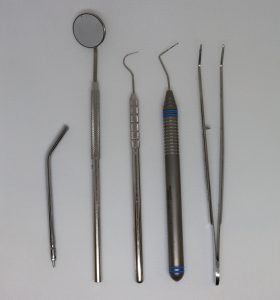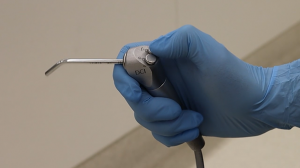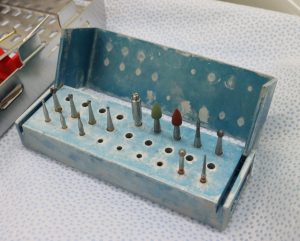Introduction to the dental clinic
Instruments
Sowmya Shetty and Nicole Stormon
Learning Objectives
Understand the general principles of using instruments in dentistry.
Know the parts of a dental instrument and their functions.
Appreciate the broad types of instruments used in dental practice.
Demonstrate the safe and correct use of common equipment and instruments in dentistry.
Principles
Dental instruments are used for various purposes, ranging from clinical examination, isolating teeth from moisture, cleaning, preparing, restoring and even removing teeth and associated tissue. These include triplex air and water, manually driven instruments, referred to as hand-instruments and handpiece driven rotary instruments. Instruments can be single-use disposable or re-useable after suitable decontamination and sterilisation.
Hand instruments
Hand instruments are manufactured from medical grade stainless steel. Most hand instruments have a handle, shank and working end arrangement. They can be then broadly described as cutting and non-cutting variations.
Cutting hand instruments will normally have a blade for the working end which is made from carbon steel or tungsten carbide for increased cutting efficiency, longevity and strength. They can have different shapes such as a round or oval scoop with a circumferential cutting edge (i.e. spoon excavator), a flat surface with an angled cutting edge (i.e. hatchet, chisel) or a curved cutting edge (i.e. scaler).
Non-cutting instruments working ends can either be a blunt or pointed end such as a tyne (i.e. probe for exploring), a textured or non textured nib (i.e. condenser) or even an angled flat non-cutting blade (i.e. flat plastics).
General uses for hand instruments include examination, periodontal cleaning and scaling, removal of carious lesions and cavity preparation, placement and shaping of preventative and restorative materials, and for retaining restorative materials while placing and shaping; and also for moisture control and isolation of tooth surfaces within the oral environment.
Common hand instruments categorised by use:
 Examination:
Examination:
- mouth mirror
- straight probe
- periodontal probes (examples: WHO, Williams, Naber’s, Briault’s)
- tweezers
Periodontal cleaning and scaling:
- Sickle scaler
- Universal scalers – anterior and posterior
- Area specific scalers – Gracey’s scalers.
Removal of dental carious lesions and cavity preparation:
- Hand (spoon) excavators – large, medium, small
- Straight or hatchet chisels
- Gingival marginal trimmer
Placement and shaping of preventive and restorative materials:
- Thymosin probe (liner placing instrument)
- Amalgam gun
- Condensers (sometimes called as pluggers)
- Composite plastic instruments usually gold or Teflon coated
- Half Hollenbach carver
- Round ended burnishers
- Flat plastic
- Scissors
Retaining restorative materials while placing and shaping:
- Matrices and retainers
Isolation of teeth and moisture control:
- Dental dam clamps and forceps
- Cotton roll holders
- Suction tips
- Triplex tip
Triplex syringe

A dental triplex is an air and water syringe. A triplex can be considered an instrument as the tip of the syringe has a number of functions and uses in all dental procedures.
The triplex has two buttons. One buttons sprays pressurised air out the syringe tip, the other water. When both buttons are pressed, a combination of air and water stream out of the triplex tip.
Rotary instruments
Small hand held electric and air turbine mechanical instruments in dentistry are known as handpieces.
There are four common types of handpieces; high speed, low speed, straight and prophylaxis.
All types of handpieces grip small parts in a chuck. These include dental cutting burs, coarse and fine polishing discs. These handpieces are driven by compressed air for high speeds, or by a separate electric motor for lower speeds.
High speed handpieces typically spin dental burs over 180,000 revs per minute (rpm). High speed handpieces generate heat on the tooth due to their speed and use a coolant such as water to cool down the tooth during operation. High speed handpieces are versatile and can be used for cutting tooth structure, alveolar bone and restorative materials, dependent upon the bur selected.
Slow speed handpieces operate between 600 and 30,000 rpm. As these handpieces operate slower they require burs with sharper and fluted cutting surfaces. These handpieces are typically used for burs designed for dental caries removal and polishing restorations. They have a higher ‘annoyance factor’. This is because more vibrations are produced with slower rotations of the bur.
Prophylaxis handpieces are modified slow speed handpieces. The latch function of the handpiece head is modified to receive screw type prophylaxis cups and brushes.
Straight handpieces are typically used in dental laboratories. Their straight body allows for larger burs designed for cutting materials and appliances.
Handpieces are operated using a foot pedal and the speed controlled by a digital panel.
Burs

Dental burs are small operatory bits used in handpieces to cut or polish.
Burs have a head, neck and shank. Diamond burs have varying grits, with higher course grit having the sharpest cutting ability. Burs are also made with tungsten carbide and stainless steel. Burs come in a wide range of head sizes and shapes.
Country context
Australia
The use of instruments in a dental setting are generally universal. There may be variations in the avalibility of instruments from country to country, as well as the name used of the instrument. For example, a sickle probe may be referredto as an explorer.
Practical application to the dental environment
Often instruments are grouped together in sets, relevant to types of procedures. For example the instruments for a dental examination will be combined in a cassette, including a dental mirror, sickle probe, periodontal probe and tweezers. This is fairly consistent between practices, however, consumables may differ between single use or reusable. This will be discussed in the next chapter.
For restorative procedures, there are a variety of burs that may be used. Practitioners decide which bur/burs are necessary for the procedure.
Typical examination kit with a bur stand
Key Takeaways
- Hand instruments, rotary instruments and burs are all used in dental settings for various procedures.
- Instruments are often grouped together relevant to the type of procedure.
- An examination kit is combined in a cassette with a dental mirror, sickle probe, periodontal probe and tweezers.
An instrument with a blade for the working end which is made from carbon steel or tungsten carbide.
Instruments with a working end that can either be a blunt or pointed end.
A pen like instrument that grips a small chuck for drilling teeth. Runnin gon compressed air it typically spins dental burs over 180,000 revs per minute (rpm).
A pen like instrument that grips a small chuck for drilling teeth. Running on an electric motor it typically spins dental burs between 600 and 30,000 revs per minute (rpm).
Similar to a slow speed handpiece, however the handpiece head is modified to receive screw type prophylaxis cups and brushes.
Similar to a slow speed handpiece, however their straight body allows for larger burs designed for cutting materials and appliances.
Dental burs are small operatory bits used in handpieces to cut or polish.

